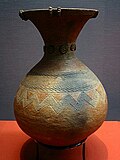Yayoi period
De LibreFind
| Advanced search |
- About 4 results found and you can help!
The is an Iron Age era in the history of Japan traditionally dated 300 BC to 300 AD. It is named after the neighbourhood of Tokyo where archaeologists first uncovered artifacts and features from that era. Distinguishing characteristics of the Yayoi period include the appearance of new pottery styles and the start of an intensive rice agriculture in paddy fields. Techniques in metallurgy based on the use of bronze and iron were also introduced in this period. A hierarchical social class structure also emerged in this period. The Yayoi followed the Jōmon period (14,000–300 BC) and Yayoi culture flourished in a geographic area from southern Kyūshū to northern Honshū.
- Related: Xu Fu, Emishi people
| Yayoi Culture Yayoi Culture www.metmuseum.org/toah/hd/yayo/hd_yayo.htm - Web |
| Yayoi period Yayoi period www.yamasa.org/history/english/yayoi_jidai.html - Web |
| An article An article www.wsu.edu:8080/~dee/ANCJAPAN/YAYOI.HTM - Web |
Gallery for «Yayoi period»
Average relevance
| Article "Japanese Roots Surprisingly Shallow" from... Article "Japanese Roots Surprisingly Shallow" from Japan Times www.trussel.com/prehist/news146.htm - Web |




